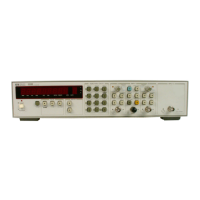a. Connect the HP 8656B Signal Generator RF OUTPUT to INPUT C of the HP 5334B. Set up the HP
8656B and HP 5334B as follows:
FREQ
C
.....................................................
ON
Frequency
...................................................
90
Amplitude
..................................................
-30 dBm
b. Using an oscilloscope or digital voltmeter, check for 1.2V
+-
0.4V at pin
1
of U306. If -1.2V
+-
0.4V is
present at pin 1, perform step c. However,
if
-1.2V
+-
0.4V is not present at pin 1, perform the follow-
ing steps:
1.
Perform the procedure in paragraph 8-445, Troubleshooting the 30 dB Amplifier Circuit.
2.
If the RF signal was not present in the previous step (1) the Peak Detector circuit is suspected;
thus, perform the procedures in paragraph 8-449, Troubleshooting of the Peak Detector Circuit.
c. Remove the signal from INPUT C and observe
-
5.OV
+
0.4V at pin
1
of U306. Now, read and per-
form, if necessary, the following steps:
1.
When -5.OV +-0.4V is present at U306 pin 1, the Peak Detector is working properly, but a
problem that is causing an incorrect count might exist
in
the Divider circuit. If this is the case,
perform procedure
in
paragraph 8-447, Troubleshooting the Divider circuit.
2.
If
-1.2Vk0.4V is present at U306 pin 1, the Threshold Comparator is always enabling the
Divider circuit. Note that HP
5334B displays a random count. If this is the case, perform the
procedure in in paragraph 8-454, Troubleshooting the Threshold Comparator.
d. Repeat steps a through c with HP
8656A set to output a
990
MHz signal.
8-445.
Troubleshooting the
30
dB
Amplifier Circuit
8-446. The input signal is received through the INPUT C connector and routed to the Channel C Input Block
where it is coupled, attenuated, and fed to pin 3 of
U305 (the first stage of the 30 dB Amplifier) and through
U304, and U303. The output of the amplifier is then fed to the Peak Detector and Divider. To troubleshoot the
amplifier chain perform the following:
a.
With no signal applied to Channel C, check for a dc bias of 4 to 6 volts at pin
1
of U303, U304, and
U305. (Pin
1
is the output and
is
the square pad located at the rear of the amplifier.)
1.
If an output is lower than 4 Vdc, the pull-up resistors for the particular output are suspected.
2. If an output is at zero volts, check for a short to ground. If the outputs are not shorted to
ground then perform the next step,
b.
b.
Check the input voltage at each of the amplitiers (U303, U304, and U305) at pin
3
for a 1.6 volts dc
level. If you measured a different voltage at any of the inputs, the pull-up resistors for the particular
input are suspected.
c. Connect a
90MHz signal at
-
10 dBm to INPUT C.
d.
Now, using an HP
8565A Spectrum Analyzer, trace the signal through the amplifier chain to find
where the signal drops out.
HP
5334B
-
Service
Manual
8-72

